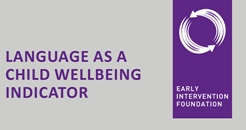 Language as a child wellbeing indicator
Language as a child wellbeing indicator
From a report by Early Years Foundation
Early Years Foundation in collaboration with Newcastle University published, in September 2017, a report on how language development in early years links to social, emotional and learning outcomes in later years. This shows that early language development is a primary indicator of child wellbeing.
Here are some report highlights:
-
Studies suggest that 5–8% of all children in England and Wales are likely to have language difficulties.
-
Children from socially disadvantaged families are more than twice as likely to be diagnosed with a language problem.
-
Disparities in child language capabilities are recognisable in the second year of life and are clearly having an impact by the time children enter school.
-
Language skills play a key role in children’s school attainment and employment opportunities thus impacting children’s longer-term life chances and social mobility.
-
Language difficulties are caused by a variety of biological, genetic and environmental factors.
-
In young children, language problems typically present themselves as delays in their ability to produce and understand language.
-
It is not uncommon for children to outgrow initial language delays, although it is difficult to predict when and how this will occur.
-
A variety of systems exist to measure differences in children’s language development and diagnose language problems.
-
Ongoing monitoring can ensure that children receive the appropriate services when language difficulties are identified.
-
Speech, language and communication difficulties account for approximately 21% of all special educational needs within England’s primary education system.
-
Children with language difficulties fall behind their typically developing peers in academic achievement at every stage of education, from the Early Years Foundation Stage right through to GCSE level and above.
-
The long-term impact of poor literacy and academic achievement means these children are at greater risk of mental health difficulties, offending, and entering the criminal justice system.
-
50% of the UK prison population are reported to have literacy difficulties, compared with 17% of the general population.
-
Over 74% of young people in a youth offenders institute have below average communication skills, and over 60% have speech, language and communication needs.
-
Socioeconomic status (SES) is a risk factor for poor language environments. Children growing up in low-income households on average hear far fewer words and are exposed to a more limited vocabulary than those in middle and higher-income homes.
-
Income-related differences also exist in the ways in which parents talk to their children. Parents with professional backgrounds are more likely to ask questions and engage in language-rich activities with their children in comparison to low-income parents.
-
The impact of social disadvantage on language development is evident at the preschool stage, at school entry and in later education; many children from low-SES families lag behind their high-SES counterparts in their language and reading test scores.
-
The negative impacts of SES on language development over time risk creating or perpetuating intergenerational cycles that preserve poverty and reinforce national inequalities in SES.
Income-related gaps in children’s early language cannot be rectified simply through changes in family income. Policies and practices must also address factors affecting the quality of the home learning environment. Increasing family access to enriching resources, such as books, toys and educational experiences, is unlikely to be sufficient. Strategies should also support the quality of parent–child interaction, including the quality of conversations parents have with their children. Strategies should start early, certainly before children enter preschool and preferably before children are 2 years old. Strategies should not end in preschool but continue throughout a child’s education, to ensure that the benefits of enriching early experiences are sustained. Strategies that support parents’ own educational development are also likely to enhance children’s early learning.
Recommendations are:
-
Children’s language development should be viewed as a public health wellbeing indicator, rather than just as an individual or ‘clinical’ concern.
-
Child language development should be formally monitored between age two and five, so that those not making good progress are offered additional support.
-
Child language should be included as part of a national strategy for promoting social mobility.
-
Future research should consider the impact of childhood language development on an individual’s life course.
-
More robust evaluation research is required to test and develop interventions aimed at supporting children’s language development.
-
The adoption of common criteria and terminology to measure and identify language difficulties would assist in the development of a coherent and replicable model of intervention and research.
-
We need to better understand the costs of early language difficulties at a societal level alongside the potential benefits of effective interventions.
-
There is a need within an educational context for a better understanding of the relationship between oral language skills and literacy.
-
There is a need for local authorities and schools to be explicit about the offer they are making to the parents of children identified with speech, language and communication needs.
The report can be downloaded from here.
See also Wide division in building good childhood foundations in high-low socio-economic families
Retweet about this article:
Early Years Foundation, 11/10/2017